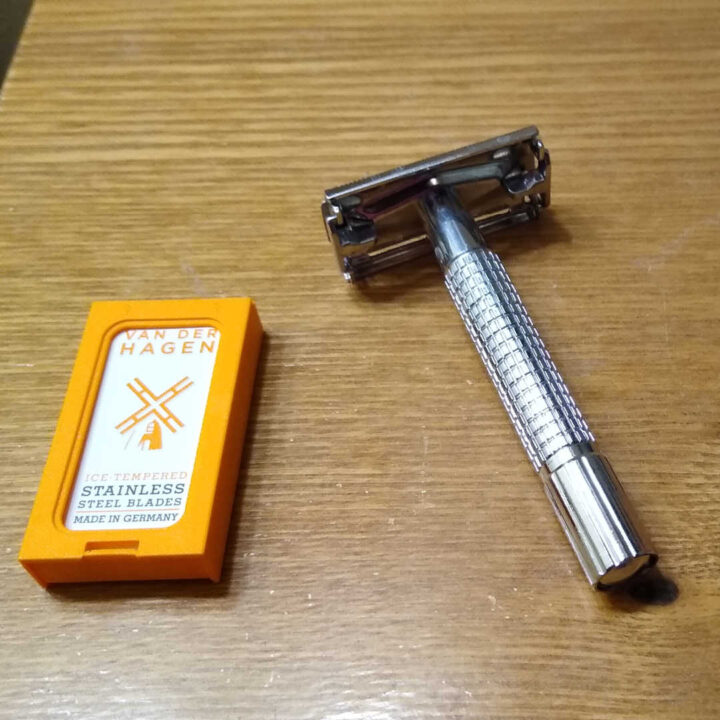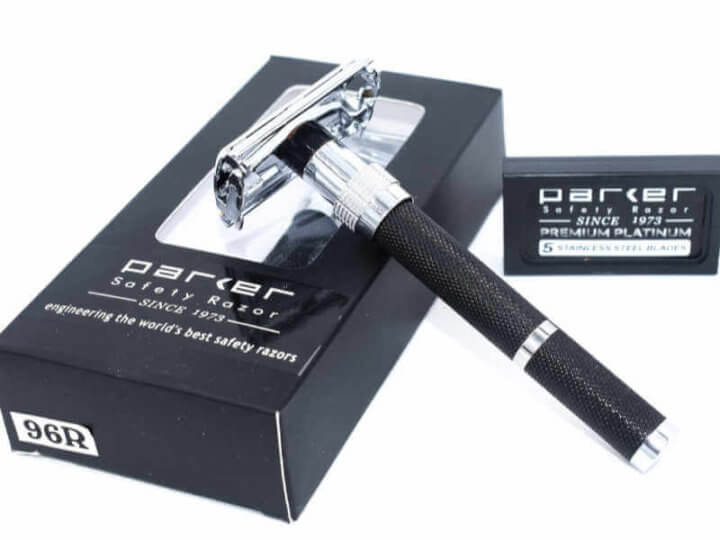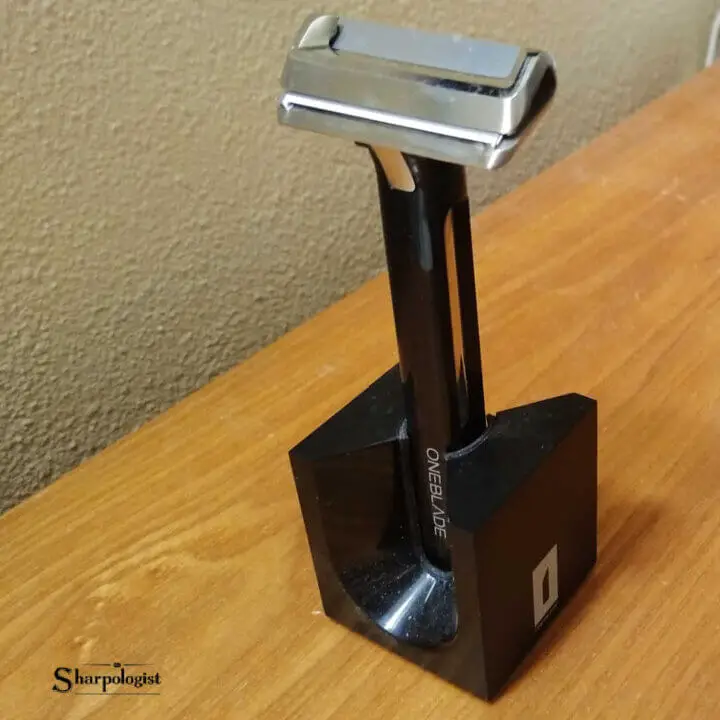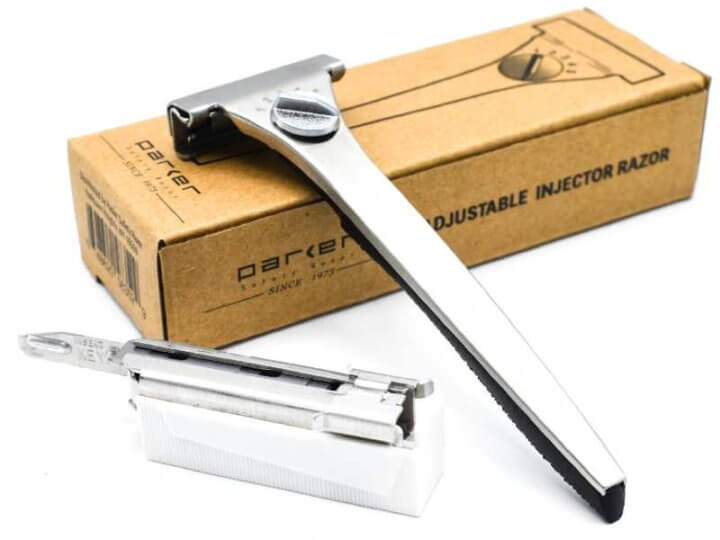
I’m here to compare two popular safety razor options – double-edge (“DE”) and single-edge (“SE”). I have tried many razors of both types and while both options come with their fair share of advantages, it’s important to understand which one might better meet your specific needs. After all, the right razor can make a big difference in your grooming experience.
In this post I’ll take an in-depth look at the differences between these two types of razors and their advantages and disadvantages. I’ll also discuss factors to consider when choosing between them based on your skin type and level of experience. Lastly, I’ll have curated a list of double-edge and single-edge safety razors for you to try out.
Note that the specific razors that I’ll discuss here are currently new and available. There are a ton of vintage razors that may be available but the additional purchase factors are out of the scope of this article.
And another special note. Double edge razors can be snapped in half for use in some specialized razors. But…that’s another article. 🙂
Double-Edge vs. Single-Edge Safety Razors – Key Takeaways
- Double edge blades have two shaving edges and are generally thinner; single edge blades have one shaving edge and are generally thicker.
- There is more standardization with double edge blades than single edge blades.
- There is much more handle and blade choice with double edge razors.
- Double edge razors and blades are generally less expensive than their single edge counterparts.
- Single edge razor handles are generally more ergonomically designed than double edge razor handles.
- Single edge razors have less of a learning curve than double edge razors.
Anatomy of a Double-Edge Safety Razor
A double-edge safety razor has a few key components and are typically constructed in one of three ways.
- A three piece razor is the “classic” (and easiest to manufacture) type, consisting of a handle, a base plate, and a head or cap.
- A two piece razor has the base plate permanently mounted to the handle.
- A one piece “twist to open” (TTO) or “butterfly” safety razor was the type most common just before the ascent of modern cartridge razors: the Gillette SuperSpeed is the classic TTO.

Handle
The handle, usually made of metal but other materials as well (even wood), provides a sturdy grip while shaving.
Base Plate
Safety razors base plates can be divided into two general groups: Open Comb and Safety Bar. Open Comb safety razors have obvious “teeth” that help guide heavy stubble and shaving cream into channels. Safety Bar (sometimes referred to as closed comb) razors have a solid (or scalloped) bar that provides some additional protection to the skin from the blade’s edge.
Cap
The cap of a double edge razor “tops off” the razor’s head, providing another surface against the shaver’s skin and helping clamp a blade securely into the razor.
Anatomy of a Single-Edge Safety Razor
The single-edge safety razor typically has a simple and straightforward anatomy. It also consists of a handle, a guard, a blade, and a cap, but usually (but not always) as a one piece unit. The blade fits between the cap and the guard, and the guard keeps the blade at a constant angle, ensuring a precise and safe shave. The cap also helps to protect the skin from the sharpness of the blade. The handle is often made of a durable material like metal or even solid plastic, while the guard and cap are made of metal.
The overall design of a single edge safety razor is generally more ergonomic than that of a double edge safety razor.
Blades for Double-Edge Safety Razors

The most important aspect of the double-edge razor is the blade itself. These blades are characterized by their sharpness, thinness, and standard size, making them compatible with a variety of brands.
There is also a wide variety of blade specifications (edge grinding, non-stick coatings, metallurgy, etc.) for an individual shaver to choose from based on hair type and skin sensitivity.
Blades for Single-Edge Safety Razors
When it comes to blades for single-edge safety razors, there are a few different options to choose from. Although there is a standard design for double-edge razor blades, this is not the case with single edge blades.
Single edge safety razors fall into four broad categories, each requiring specific blades. Injector blades, GEM blades, “barber” blades (such as Feather Artist Club and KAI brands), and FHS blades. Despite this diversity, many who try single edge razors never look back.
Injector
The injector razor blade is a piece of shaving hardware that has been around for a considerable amount of time, with Schick being the most well-known company in this area. Schick became the first company to sell stainless steel blades coated in Teflon and the first to successfully deposit a thin layer of chromium onto the blade, making the blades more durable.
While Schick no longer manufactures Injector razors, several other companies have been successful with the design.

Barber
“Barber” blades–sometimes called shaper blades, Artist Club ( or “AC”) blades (after the Feather brand Artist Club product line), or folding razor blades–look quite similar to Injector blades but a bit larger. Several razor artisans make safety razors that accept these blades.
GEM

The history of the Gem Safety Razor dates back about 200 years. Despite popular belief, it was not the first safety razor developed. Before the Gem, there was the Star Razor, introduced in 1875 by the Kampfe Brothers.
Today only artisan razor makers offer GEM-type razors. Larger companies have long abandoned the design. However GEM blades are still available.
FHS

Currently only produced by one company, Feather, the FHS blade was originally designed for the vintage Valet Autostrop razor. This razor was produced from the early-to-mid 1900’s. While the Autostrop razor is long gone, the FHS blade is used in the modern OneBlade razor (more on that later).
Advantages Of A Double Edge Razor
As a wet-shaving enthusiast, I’ve found that double-edge razors provide some notable benefits over other types of razors. I think the biggest benefit of adopting double-edge safety razors lies in their long-term cost savings compared to electric shavers or cartridges.
While the initial investment might seem high to those unfamiliar, it’s far more cost-effective down the line due to inexpensive replacement blades – often just pennies per piece – which last longer than disposable cartridges (or need regular charging like electric shavers). These blades are widely used and easily accessible, making it convenient for users to replace their blades when necessary.
Double-edge razors can help minimize razor bumps and other skin conditions by using thinner sharp single blades that glide smoothly across the face, reducing irritation and ingrown hairs.
The design of double-edge safety razors also makes for easy cleaning and maintenance, without any complex mechanisms to disassemble.
Disadvantages
Double edge safety razors have numerous benefits such as being cost-effective, providing a closer shave, and producing less waste. However, they also have their disadvantages.
There is a higher learning curve to using a double-edge safety razor, as it requires more technique and skill compared to most single edge or cartridge razors. This can result in nicks and cuts, especially for those new to wet shaving.
Moreover, changing blades can be time-consuming and may require more effort compared to other razors. Some razors mitigate this by using a “twist-to-open” (TTO) razor design and a blade magazine that stores razor blades such that they can slide out and onto the TTO razor head.
Finally, double-edge safety razors may not be as effective at shaving coarse or thick hair, which can lead to uneven results.
While these disadvantages may not affect everyone, they are important considerations when deciding whether to use a double-edge safety razor.
Advantages Of A Single Blade Razor

Single edge safety razors have several advantages over their double-edge counterparts.
I think single edge razors may be more approachable for beginners due to their more ergonomic design. And a single edge blade–one sharp edge instead of two– makes them less intimidating during handling.
In terms of shaving precision and control, single-edge razors can really shine. They can allow for greater control over shaving angles and can get into tight spaces more easily. This is particularly useful when working around difficult areas such as the chin or under the nose. Users can achieve good results with less worry about nicks or cuts.
They also have fewer moving parts than their double-edge counterparts, making them easier to clean and maintain.
Disadvantages
Single-edge safety razors have some disadvantages that make them less popular than double-edge razors, despite their unique benefits. One disadvantage is the limited availability of single-edge razor blades.
Double-edge razor blades are more widely available and come from various brands. In contrast, single-edge razors have different blade requirements and fewer manufacturers, making it more difficult to find compatible blades.
Factors To Consider When Choosing Between A Single Edge And A Double Edge Razor
When it comes to choosing between a double-edge and single-edge safety razor, I think several factors need to be taken into account. Let’s take a closer look at each one.
Skin Type And Sensitivity
When it comes to choosing between double-edge and single-edge safety razors, your skin type and sensitivity is important to consider. Those with sensitive skin may be better suited for double-edge razors that usually provide reduced irritation. On the other hand, those with thicker, more “wiry” facial hair (especially graying hair like me!) can benefit from the closer shave provided by single-edge razors and their thicker, more stable blades, which may cause less irritation in those circumstances.
Level of Shaving Experience

If you are new to wet shaving, I believe a single-edge razor may be easier to use and require less skill and technique. Shaving with a single-edge razor will be more familiar to those who have used cartridge razors.
On the other hand, experienced shavers may prefer the closer shave and greater control over angle and pressure that a double-edge razor can offer.
Desired Level of Control and Precision
When it comes to achieving the desired level of control and precision, single-edge razors are the way to go. These razors offer a degree of accuracy that is more difficult to match by their double-edge counterparts due to a single-edge razor’s smaller head. The single blade design allows for more precise shaving angles, making them good for grooming tight spots or hard-to-reach areas like the chin or under the nose.
Razors To Illustrate These Concepts
So what are some razors that illustrate the differences between double edge and single edge designs and techniques? I have tried a lot of razors over the years and I decided on a small selection of razors for specific reasons, which I will get into as I describe them. These razors may not be the “best” for everyone but they will help you understand the differences.
[Note: Amazon, OneBlade, PAA, and Supply and links are affiliate.]
Double Edge Razors To Consider
Van Der Hagen Safety Razor

The Van Der Hagen Traditional Safety Razor is a popular (and a lot of times the only) choice among those who are looking for an entry-level safety razor that is inexpensive and widely available at “brick and mortar” locations in the U.S.
The razor has chrome-plated brass construction and a vintage look. The butterfly opening allows for a quick and easy blade change, making it a convenient option for those who are new to safety razors. The razor is a good weight (59 grams, about two ounces), with a textured three inch handle which gives a secure grip even with wet and soapy hands. This razor is manufactured in China.
The shave is very mild and I think this razor is targeted to beginners transitioning from cartridge razors.
Parker 96R

As a contrast to the Van Der Hagen razor, the Parker 92R is also a butterfly-style razor more aggressive, with a fair amount of blade exposure (but not so much that I can’t enjoy using it). It might be too much for a beginner, though. I think it has a fairly generous razor/blade angle range–in other words I can hold the razor at different angles and still get a ‘safe’ cut on my stubble.
Merkur 23C

The Merkur 23C is a three piece razor. The handle is long, which can be good if you have big hands, but is lighter and has a smaller diameter which may not be good if you have big hands.
It’s relatively light–if you like light razors–and reasonably well constructed. But the top cap threaded screw is a weak point in the design. The shave is entirely “middle of the road,” and finding the “sweet spot” angle is easy, which will be fine for most people…unless you like a really mild or really aggressive razor.
I think the Merkur 23C is a good, solid, all-around double edge razor.
Merkur 34C

Appearing at or near the top of the most vendor sales lists the Merkur 34C (also known as the “HD,” “Heavy Duty,” or “Heavy Classic”) is practically a legend in the old school wet shaving community.
This two piece double edge safety razor has been around for a long time and continues to dominate the “old school” wet shaving landscape. Its engineering design and build quality have become a baseline on which other razors are compared. And its shave is suitable for a wide variety of people.
Parker Variant

The vast majority of razors have a set gap space, the distance between the razor blade’s edge and the razor’s skin safety bar: the amount of the gap distance is determined by the manufacturer for a particular model of razor.
However an adjustable safety razor can change the gap to make them more gentle or more aggressive. The Parker Variant adjustable double edge razor is a popular choice.
Blades
Take the time to try a number of different blade brands to find the one(s) that work best for the razor you’re using (your skin, the mineral content of the water you’re using, and the shave lather you’re using play parts too). Even if you are already using a double edge razor you may need to do some additional blade experimentation if you buy another one. It will make a difference in your shaving experience.
Some shaving vendors sell sample packs or “blade samplers” to make the process easier: you get a few blades of many different types. After you decide which one(s) work best you can then buy your favorites in bulk.
Single Edge Razors To Consider
While double edge safety razors broadly share blade and handle characteristics, single edge razors have fewer common elements. Here is a selection.
OneBlade

OneBlade razors use the Feather FHS blade. Unlike most other safety razors, the OneBlade razors take a page from modern cartridge razor design by using a front-facing pivot, providing for a much more consistent shave.
There are three models of the OneBlade razor, each at a different price point. The OneBlade genesis is my favorite safety razor (single edge or double edge).
Supply

The Supply SE razor uses Injector blades. At the moment there are only three manufacturing facilities for Injector blades: one in the U.S., one in China, and one in Japan.
Inserting an Injector blade (Supply’s “Black Label” blades or other Injector-style blades) is easy and smooth. Unlike most double edge razors and blades it is largely a “hands off” process.
The razor is solidly-built and hefty but well-balanced. The finish of the razor is smooth but there still is enough grip for the razor to feel secure in my hand but for those looking for an extra measure of safety Supply offers a silicon grip that slides over the handle.
I find the Supply SE razor to be forgiving, drama-free and very effective.
Parker

Parker also offers an Injector razor but with different design and engineering characteristics that distinguish it from the Supply razor.
PAA

Phoenix Artisan Accoutrements (PAA) offers their Starling GEM single edge razor. The original GEM razor designs of the early 1900’s featured a one piece razor with a pop-up cap but the Starling is a three piece razor.
My own use and the other reviews generally regard the Starling as a fairly aggressive razor.
Blackland

Blackland offers their Sabre GEM single edge razor. Like the PAA GEM razor, the Sabre is a three piece razor. Blackland offers it with two different base plates, “L1” for a (very) mild blade gap and “L2” for a more middle-of-the-road feel.
Blackland has a reputation for top-notch build quality (at a commensurate price) and the Sabre is no exception. The razor feels solid and well-balanced in my hand, though it does have this quirky rectangular top cap post, threaded on two sides, that can make razor reassembly after blade insertion interesting (for me, anyway). I think the blade angle “sweet spot” is quite narrow on the Sabre but after you get a handle on it the razor works well.
Barber Blades

Bullgoose offers their Asylum RX (v2) single edge razor.
Blackland has a barber blade single edge razor called the Vector.
RazoRock takes a bit of a different tack with their Hawk single edge razor: while other artisan razors are sold at an artisan (read: expensive!) price point, the Hawk is more value-priced, being made from aluminum. It’s lighter in weight compared to others but I think it’s quite nicely balanced and it shaves me well.
Conclusion
In the battle between double-edge and single-edge safety razors, there is no clear winner. Both types have their pros and cons, ultimately coming down to personal preference.
If you have sensitive skin or want to save money in the long run, a double-edge razor may be best for you. But if you’re looking for precision and easier handling, a single-edge razor might suit your needs better.
Whichever type of razor you choose, remember that technique also plays a big role in achieving an exceptional shave experience.

I switched back to a vintage single edged razor recently. My biggest problem is finding good blades, as most seem to be manufactured for paint scrapers … and feel like that while shaving. My other concern (and one of the reasons for going back to my vintage razor) is to avoid plastic. Any suggestions for quality blades, with a bonus if they aren’t packaged in those thick plastic containers.
Thanks.
But,…….. have you tried a GEM yet?
The Twig and Thorn razors made by Leaf are great single edge razors. Surprised they weren’t mentioned here.
Hi Marc– As I mention in the article, double edge blades snapped in half is a special case and I’ll be doing a separate post on those.
So sorry. I skimmed your article quickly and didn’t see that.
Thanks!
The Razorock Hawk is also available in stainless steel, with standard, aggressive and open comb versions.
I’m still in awe of my Feather AS-D2 razor using Feather blades and Jack Black Beard Lube. Shaving 6 days a week with no nicks, bumps or razor burns. Ever.
Hello,
Would you please name all 6 razors in the the first photo. I do not recognize a couple of them.
thanks
From top, clockwise: Feather AS-D2, Hype Injector (review coming), Supply Injector, Parker 78R, Asylyum Rx
Thanks very much.
I count five in your list, but I see six razors.
Oops, sorry, between the Parker 78R and the Asylym Rx is a Parker Variant. 🙂
Comments are closed.